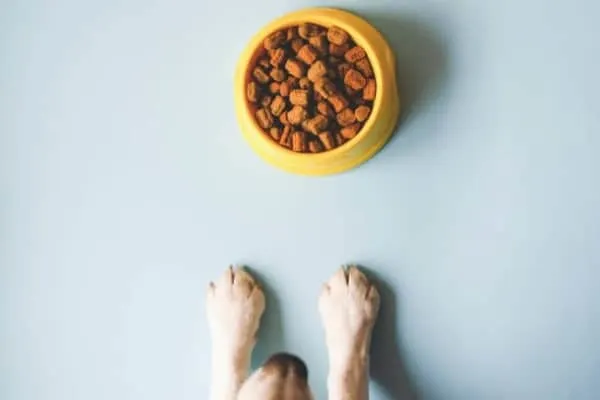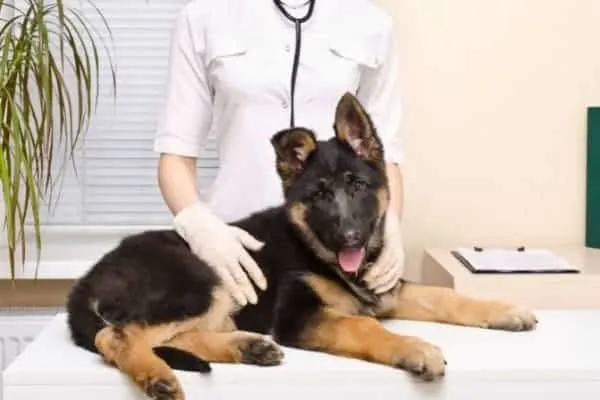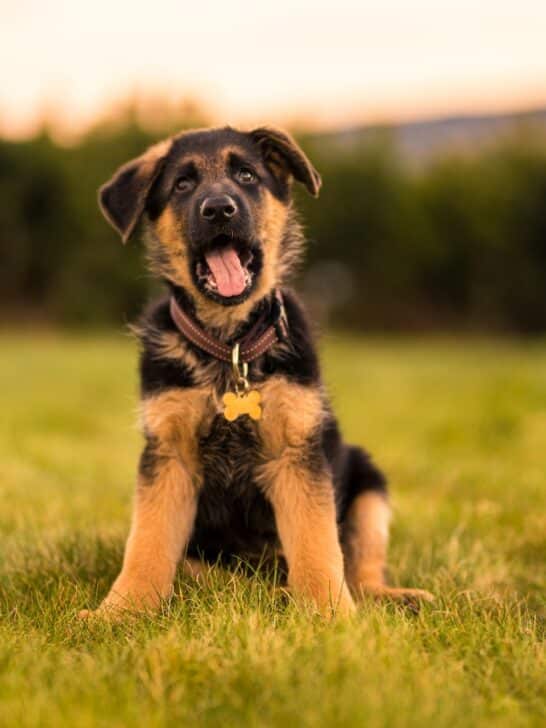When Should You Switch a German Shepherd Puppy to Adult Dog Food?
In most cases, the switch to adult food will take place around 8 to 16 months.
However, this change is one that you need to make gradually, and in keeping with your dog’s individual nutritional needs.

What is the Optimal Way to Feed Your German Shepherd Puppy?
According to Total German Shepherd, all feeding changes should be made gradually to ensure the best possible results.
The food recommended by the breeder or rescue organization should be used for the first few weeks to avoid digestive disruption, and kibble should be mixed with a little water.
Clean water should be available to your puppy all day but taken up at night.
Puppies between eight and 12 weeks old do best with being fed three or four times daily. After 12 weeks, feeding your puppy twice a day is fine.
Any changes to the amount of food a puppy eats should be done gradually.
Puppies will experience their most significant growth rates between three and six months old.
It’s essential to monitor your puppy’s weight during this time because, even at this age, getting overweight can lead to joint problems later in life.
What is the Best Age to Switch Your German Shepherd to Adult Food?
A good rule of thumb for switching your German Shepherd to adult food is doing so when they have achieved 80 to 90% of their adult size.
In most cases, this will be around a year old, although larger males might take longer to reach this size.

How Does the Right Food Play a Role in Your German Shepherd’s Health?
The Happy Puppy Site states that a lot of problems German Shepherds can encounter are due to bone growth that occurs too rapidly. These issues include hip dysplasia.
Choosing the right food and feeding the right amount both play a leading role in making sure your puppy grows at an acceptable rate.
The first several months of a German Shepherd Dog’s life are crucial for ensuring an appropriate growth rate.
A raw diet might prove beneficial once your dog has reached adult size. One of the possible benefits is reducing the possibility of hip dysplasia.
When your puppy has a growth rate that follows a proper pace, the dog will reach the appropriate proportions when they are supposed to.
Even though all dogs run the risk of injury, a puppy that grows at the appropriate rate has healthier bones.
What is the Best Type of Food to Transition Your German Shepherd Puppy to?
Puppy food for large breeds with a high protein level is best for German Shepherd puppies.
Whenever possible, it is always a good idea to continue the same brand and essential formulation, but to switch to the adult version when appropriate.
You will not only avoid any issues with finicky behavior but will also help ensure that your puppy continues to meet its essential nutritional needs.
The outcome of taking these steps will be better overall health for your dog.
Replace 1/4 of their current food with the new food for two days.
Then, you will replace half the food for two days and three-quarters for two days, ultimately making the switch totally to the new food.
This process should take two to four weeks.
This video helps put the process of switching your dog over to another food into perspective.
This relatively simple step is an essential way of making sure that your dog is nourished.
Avoid adding supplements, because they may add too many nutrients that are already present in the food.
Eggs, cooked vegetables, or yogurt make suitable additives for better digestion or flavor variety if you want to provide a treat.
How Do I Know my Dog is Getting the Right Amount?
Amanda J. Hawthorne encourages feeding your dog according to the manufacturer’s nutritional guidelines.
These guidelines may vary depending on the brand and formulation.
Make sure your dog keeps a healthy weight. The spine, ribs, and pelvic bones should be easy to lightly feel. All GSDs should have a visible waistline.
If the food your puppy is eating seems to be leaving them unsatisfied or they do not appear to be gaining healthy weight levels, you may need to consider following up with your veterinarian.
What Types of Foods Should a German Shepherd Puppy Never Get?
Medium-length beef marrow bones can be a tasty treat in addition to their food, especially if stuffed with pumpkin without any spices or peanut butter.
However, avoid pork or poultry bones, because these can splinter very easily.
Gravy should never be given as a treat because of its potential to cause diarrhea. Another concern is that gravy might contain spices possibly toxic to dogs.
Avoid feeding table scraps for the same reason.
There are concerns about some kibble-based dog foods that owners should be aware of, according to Anna Burke.
These foods include grain-free varieties high in potato and legume content like lentils or peas.
Such ingredients increase the risk of canine dilated cardiomyopathy.
Large dogs like Shepherds may be somewhat more prone to this condition.
Raw food diets can be poor choices for German Shepherd puppies because it is harder to regulate your dog’s growth on this diet than you can with regular puppy food.
If you want to consider this diet, wait until your dog has achieved adult size.
Avoid homemade diets, as these are mostly deficient in crucial nutrients that growing puppies require.
If you do feed one of these types of diets, consider adding a diet “base” to the dog’s food to ensure they receive the proper nutrition.

How Does Your Vet Play a Role in Your German Shepherd’s Nutrition?
Melissa Smith notes that timing is everything when it comes to switching from puppy to adult food, and your vet will play a leading role.
One of the reasons why timing is so important is because the calorie content of puppy food is so high.
This can make the young adult dog gain weight too quickly, in the wrong places, particularly the belly area, where fat can be dangerous.
A growth spurt after a year is possible in German Shepherds, particularly males, and your vet may have a good idea of when the growth will finish.
However, what about Shepherds that are not purebred?
This question is very reasonable, as it is a little more difficult to guess when a mixed-breed is done growing.
Weekly measurements can be an excellent way to track the dog’s growth.
Compare your measurements to popular GSD growth charts for reference.
Consider making sure your vet is on-board as you make the transition from puppy food to adult.
Your vet will be able to spot any nutritional deficits that require addressing.
Another advantage is being able to ensure the dog has proper bone growth.
Your dog’s medical history will also be a factor in when the switch to adult food takes place.
If your German Shepherd has needs that require a special diet, your vet will be able to provide valuable guidance about the appropriate timing.
Even though you might find it challenging to think about obesity when your dog is transitioning out of puppyhood, this stage is not too early by any means.
Early prevention is key to stopping many conditions besides hip dysplasia.
Both obesity and being underweight can come with their share of problems for your growing dog.
Obesity, when unchecked, can not only lead to bone and joint issues but can also lead to heart disease and diabetes.
If your dog is underweight, Amber King recommends a high-protein diet with a moderate amount of fat.
Follow up with your vet to help uncover the cause of the low body weight.
Another possible health issue of concern, according to Dr. Tammy Hunter, is Osteochondritis dissecans, or OCD.
OCD is a condition that involves abnormal cartilage growth at the end of a joint.
Although the exact cause of this condition is unknown, too much calcium in the dog’s diet is one possible factor, making balanced nutrition more critical.
Wobbler syndrome is another condition that may have its origins in overly rapid growth.
This disorder is a neurological condition that affects the spinal cord in the neck area, often leading to difficulties with walking.
According to Texas A & M, this disease can manifest at both young and middle ages.

What Will Be the Overall Impact on Your German Shepherd?
When you have a growing German Shepherd, the right nutrition makes all the difference in their growth and development.
Even though it may feel as though the amount of information on nutrition is overwhelming, it is essential.
Making the right choices early on will mean greater health and happiness for your dog.
A dog that grows at a reasonable, healthy rate will do much better in life.
You’ll also have the assurance of knowing that your dog is healthier.
Recommended reading:
- What Do German Shepherds Eat? These 34 Things to Enrich Their Diet
- What Can German Shepherds Not Eat: Never Feed These 12 Foods to Your GSD






























